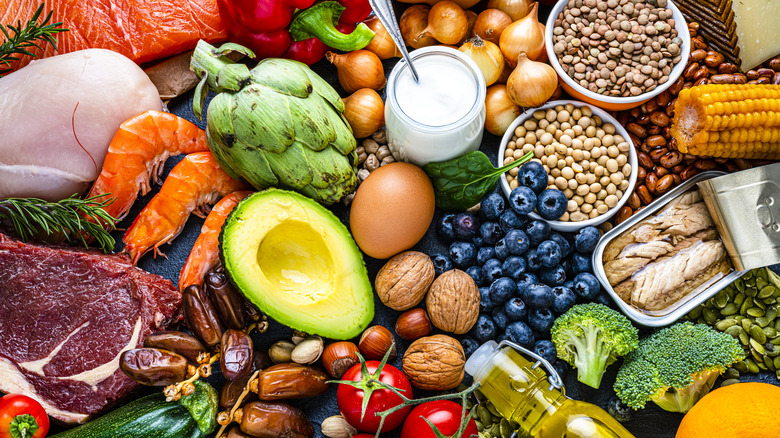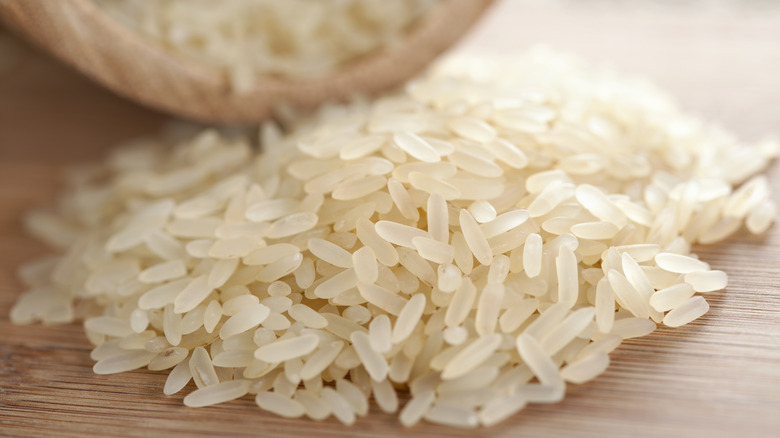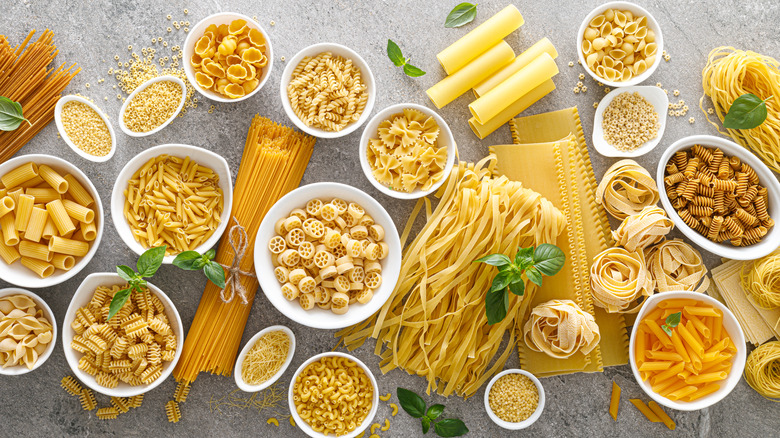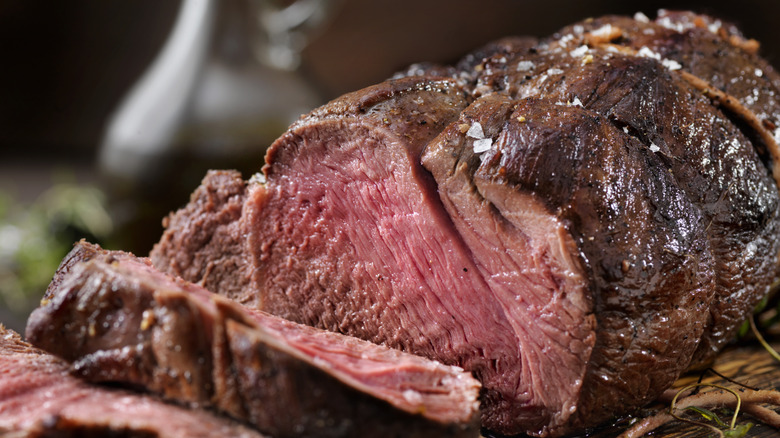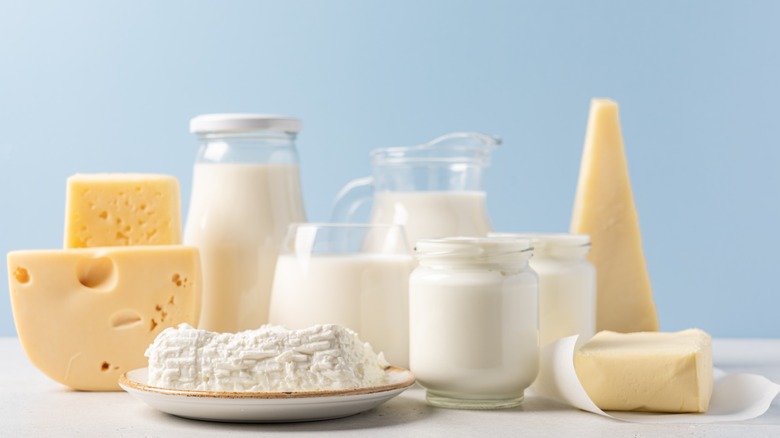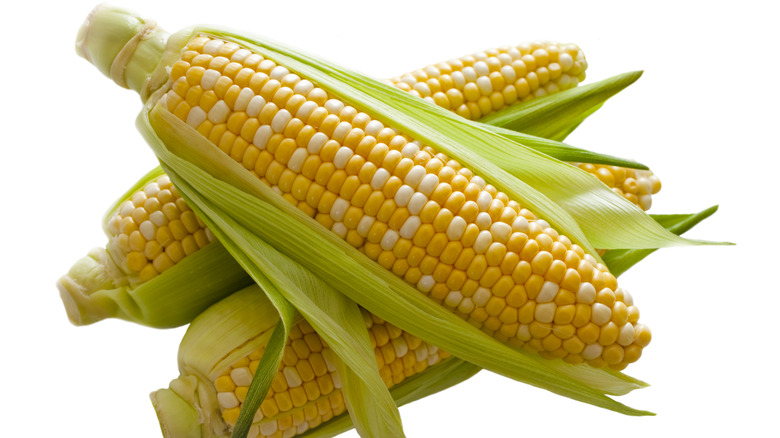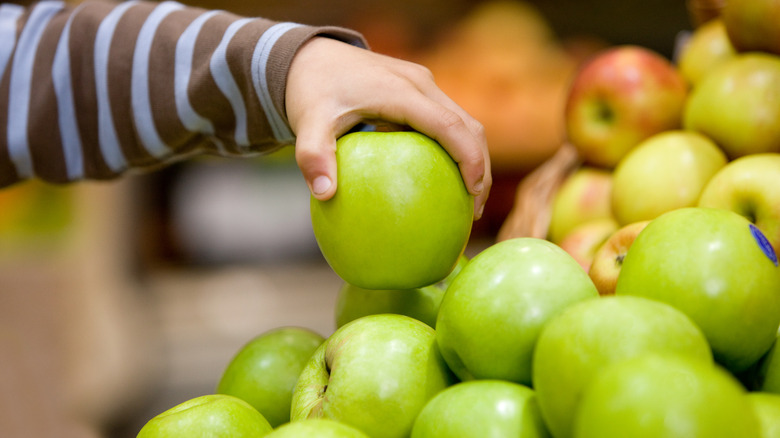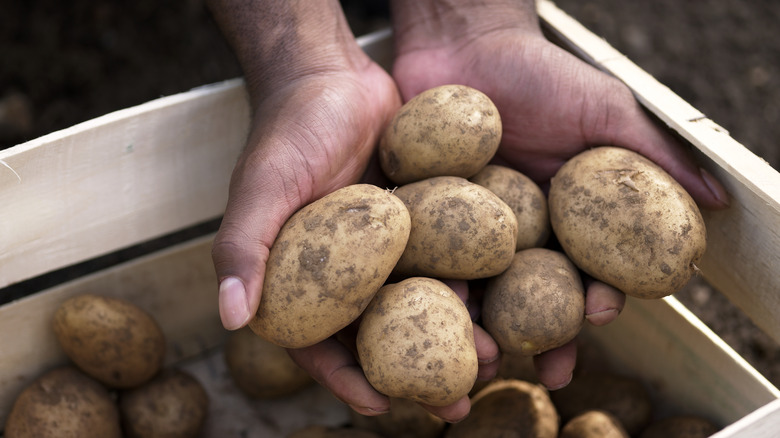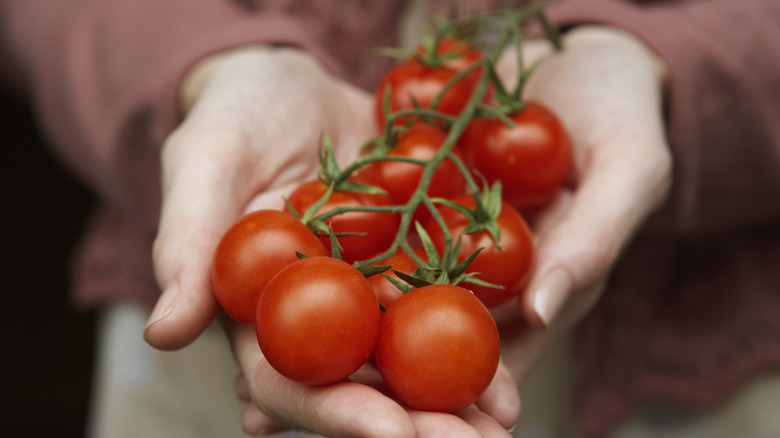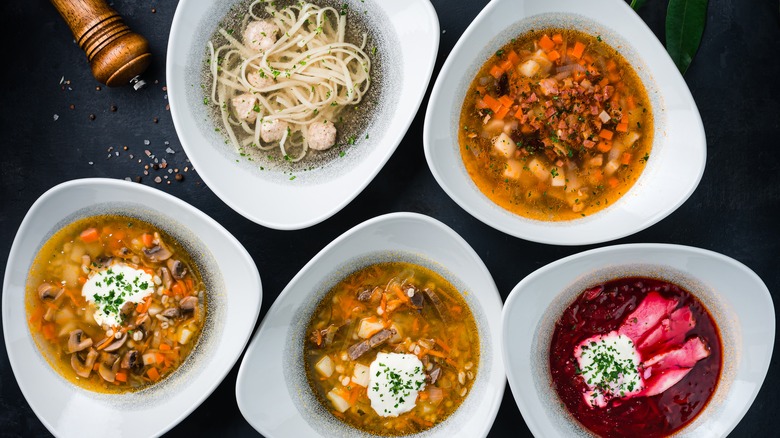These Are The Top 16 Most Eaten Foods In The World
Have you ever enjoyed a meal and wondered if it's just as popular on the other side of the globe? From fruits, grains, meats, and... pizza — our planet has a mindboggling array of flavors, textures, and traditions in a culinary landscape that seems to stretch as far as the eye can see. The potato alone has been transformed into countless unique dishes around the world!
But, despite the diversity and the different ways we cook our dishes, there are some foods that have managed to claim a universal spot on our dining tables, no matter where we may be. From the hearty staples that lay the foundation of countless meals to the indulgent delights that bring a smile to our faces, we've curated a list of foods that resonate with taste buds worldwide. Here are the top most-eaten foods in the world that have truly captured our appetites all across the globe.
1. Rice
Imagine a world without rice. For half of the global population, this is nearly impossible. Not only is it one of the most common grains in the world, it's incredibly versatile, too, transforming into Spain's paella, West Africa's fiery jollof, and India's aromatic biryani. But where does all this rice originate, and how much of it do we eat?
In the last harvest year, the world churned out nearly 510 million metric tons of this milled marvel. China stands tall as the world's premier rice titan, producing an astounding 148.277 million tons on an annual average, with India not too far behind. In rice consumption, those two countries still lead the world, followed by countries like Bangladesh, Indonesia, and Brazil. Rice consumption globally increased from 437.18 million metric tons in 2009 to 520 million in 2022. And in the US alone, Americans devoured a whopping 4.8 million metric tons of rice in 2022.
Rice is an ancient symbol of sustenance and survival — a testament to human innovation, adaptability, and the enduring power of food to connect cultures, all contained in a single grain.
2. Bread
No matter the origin of your shopping basket, it will undoubtedly contain bread and bakery items. From iconic French baguettes to the buttery naan in India and pita pockets of the Middle East, it is the cornerstone of the grandest feasts and the humblest breakfasts.
In 2016, the world saw bread imports totaling an impressive 12,038,341 tons. That year, the U.S. became the number one bread consumer, munching on 16.2 million tons of bread. And with demands for more health-consciousness options, such as whole-grain, gluten-free, and low-carb bread, the bread market is set to be worth a staggering USD 291.29 billion by 2030. Quite a lot of dough, isn't it?
From being a sacred offering in ancient temples to the sustenance for soldiers in the trenches, from the heart of family feasts to a symbol of protest and resilience in times of upheaval, bread is a binder of humanity — not just widely eaten across the world now, but in almost all of history.
3. Pasta
Pasta, with its countless shapes, sizes, and textures, is undeniably loved by millions every day. Some theories suggest that pasta was introduced to Italy by Arab traders in Sicily throughout the 8th and 9th centuries, rather than Marco Polo bringing it back to Italy after visiting China. Either way, almost everyone has seen pasta in all its twisty forms.
On average, every American consumes up to 20 pounds of pasta each year, slotting this delightful dish as the 6th most consumed food in the country. Collectively, the American appetite devours nearly 6 billion pounds yearly! The fact that the U.S. is the world's second-largest pasta producer, producing a whopping 4.4 billion pounds annually, makes sense. However, Italy still takes the cake in pasta eating, with a staggering average consumption of 50 pounds per citizen per year.
But whether you're gluten-free, vegan, or carnivorous, there's a pasta dish waiting to be discovered and devoured by you. From the creamy carbonaras of Italy to the cheesy macaroni of America, the rich beef stroganoff of Russia, or the stir-fried noodles of East Asia, every culture has embraced pasta and molded it to fit its palate.
4. Chicken
Chicken — the feathered staple that has strutted its way to almost every dinner table in the world. In 2020, chicken meat made up 35% of the world's total meat output, marking it the most produced type of meat that year. The following year witnessed an even greater appetite for poultry, with about 132.3 million tons making it into our stomachs. In fact, the U.S. stands out as the top consumer, annually accounting for approximately 16,500 tons of chicken.
But what is behind this global preference for chicken? Many view poultry as a healthier alternative, especially when comparing it to beef and pork; thus, the global demand for chicken is anticipated to grow even further. Chicken's versatility in cuisine further fuels this popularity. Whether you're roasting it, frying it, grilling it, or giving it a good ol' simmer in a pot, chicken is undeniably a global food "Most Valuable Player."
5. Pork
The versatility of pork is undeniable. It can be a German bratwurst, a Philippine lechon, or a Spanish jamón ibérico. Rubbed with a smoky dry mix or simmered in gochujang sauce — the applications are endless. With archaeological evidence of domestic pig farming dating back 10,000 years, today, the popularity of this protein-rich food makes it one of the most consumed meats on the planet.
From the 1960s to 2022, global pork production surged to 32 million tons and is projected to hit around 42 million by 2032. China has led this growth, producing half of the world's pork in 2014 and escalating to 60 million tons in 2022. Europe and the U.S. trail China in production, with Germany, Spain, and Brazil also key players.
But while chicken is the most produced meat, pork still represents 36% of all meat consumed. As for individual consumption, in 2013, the global average was about 35 pounds per person. When it comes to feasts and celebrations across the globe, pork surely knows how to hog the spotlight!
6. Beef
While beef sits at third place on the United Nations Food and Agriculture Organization's list of most-consumed meats globally, its influence is significant. From slowly grilled asado to thinly sliced and perfectly marbled Japanese Wagyu, there's no denying the world's penchant for this meat.
Beef accounts for a staggering 22% of global meat production, soaring from 30 million tons annually in 1961 to 74 million tons in 2014. That's more than double! In 2021, exports of beef and beef-related meats reached a record-breaking 1.54 million tons in value — a lot of burgers, roasts, and barbecues, mind you.
So, where's all this beefy goodness coming from? The United States leads the herd, contributing 12-13 million tons in 2014 alone. But it's not just the cowboy nation; Brazil and China are also major beef hubs, with Argentina, Australia, and India not far behind.
So, whether you're sinking your teeth into a medium-rare steak or enjoying a bowl of beef pho, take a moment to honor how beef has journeyed from ancient pastoral lands to all our kitchens today.
7. Eggs
From the silky omelets of France, the rich tamago of Japan, to the spicy egg curries of India, our relationship with consuming eggs is as diverse and widespread as it can be. But just how popular are they? Let's look at the numbers and see.
On average, global consumption in 2018 was 161 eggs per person annually, equating to three eggs per week. But the Japanese are notable egg enthusiasts, with an average of 320 eggs consumed per person each year! Other top egg-consuming countries are China, India, the USA, Indonesia, Brazil, Mexico, Japan, Russia, Germany, and France. So, whether for baking, breakfast, or even a quick snack, the whole globe is cracking eggs left, right, and center!
Eggs are a staple — they emulsify, bind, leaven, and glaze. They are painted during Easter and provide quality nutrition to everyone from all walks of life, making them the unsung heroes in many dishes as well as cultures.
8. Dairy Products
Milk, as it's said, was the first food of the gods, and it's no surprise why. Civilizations grew with dairy as sustenance, and in the modern world, dairy isn't just a fundamental source of protein and calcium but has found its way into daily routines. From crumbly feta, Greek yogurt, or creamy lattes, dairy's versatility is nothing short of commendable.
In 2019, the dairy sector produced an astounding 971 million tons of milk, which grew from 854 million tons in 1988 to 929 million tons in 2018 — a 59% increase in 30 years. By 2029, production is projected to approach 1 billion tons, growing at 1.6% annually, outpacing many agricultural commodities.
Globally, this dairy drive is powered by approximately 133 million farms, housing over 600 million individuals. Interestingly, 80 million of these are women, with almost 37 million leading their farms. Beyond just a food product, milk represents a lifestyle and mainstay for nearly 150 million households.
So, the next time you pour a glass of milk or bite into a cheesy snack, remember the vast and vibrant world of dairy that works tirelessly to bring these delights to your table.
9. Fish
Packed with protein and heart-healthy omega-3s, fish has been fueling Mediterranean feasts, Pacific Islander ceremonies, Japanese sushi markets, American coastline trade, and every place in between for centuries. Thus, fish is not just making waves but truly dominating the scene.
Fish contributes significantly to global nutrition, supplying 20% of the average animal protein for around 3.3 billion people. In 2017, it accounted for 17% of the world's animal protein intake and 7% of total proteins consumed.
The global appetite for seafood has also skyrocketed, seeing a 122% increase in consumption from 1990 to 2018. Of the 197 million tons of fish produced in 2018, a massive 88% was consumed by humans. Looking ahead, the demand for fish isn't waning, as predictions for 2030 show a potential rise in global fish production to 224 million tons.
So whether it be Latin American ceviches, Japanese teriyaki-glazed fillets, or Nordic gravlax — and may it be the mighty tuna, the elegant salmon, or the ever-popular tilapia, the pivotal role that fish play in our global cuisine and the world's food supply is not just undeniable, it is here to stay.
10. Maize
Or, as you may know it — corn. From cornstarch, corn syrup, biofuel, and, of course, corn-centric dishes such as buttered cobs, tamales, Kenyan cornmeal porridge, or popcorn, maize is one of the world's top-eaten foods.
Why? For starters, maize stands proud as one of the most produced and devoured cereal crops globally. This isn't just a recent trend; the love affair with maize can be traced back around 9,000 years to its domestication. In 2018 alone, the export value of maize touched a whopping $33.9 billion, with the U.S. and China topping the leaderboard in corn consumption. The U.S., in particular, is not only the leading producer and consumer of this golden grain, but it's also the world's largest exporter. Just to give you a taste of the scale, in 2021, the U.S. exported maize worth $18.63 billion, reflecting a 20% surge from the previous year.
In truth, America's love for corn extends past its borders. And if there were any other word that would be more intense than "staple," we for sure would be calling maize that.
11. Apples
Let's take a bite of one of the world's most consumed and beloved fruits: apples. No matter the type of apple, these crunchy delights have seen an astonishing rise in popularity over the years. To give you a perspective, in 1961, the global consumption of apples stood at 14 million tons. Fast forward to 2019, and this number skyrocketed to an impressive 75 million tons — showcasing an average annual growth rate of 2.78% and growing demand. As of 2023, the Fresh Apple Market is valued at a whopping USD 99.06 billion!
With regard to apple-loving nations, China is not only the world's largest consumer, but it's also the largest producer of fresh apples. Out of the worldwide apple consumption, China alone devours 44 million tons. In comparison, the U.S., the second-largest consumer, consumes 4.4 million tons — that's China consuming apples at ten times the rate of the U.S.!
So the next time you crunch into a juicy apple, remember you're enjoying a fruit that has captured the taste buds of billions.
12. Potatoes
Let's peel back the layers on a food that's incredibly versatile and just absolutely spud-tacular: the potato! Tracing its origin to South America, it has spread its roots (quite literally) across the globe, claiming the spot as bronze medalist for most important crop worldwide, trailing just behind rice and wheat. In fact, over a billion folks across continents have potatoes gracing their dinner plates. The global production? A staggering 300 million metric tons!
Since the 1960s, potato production has expanded so much in developing countries that it has swiftly overtaken other major food crops. It's not just about delicious fries and mash; for countless people spanning South America, Africa, and Asia, the potato is crucial for daily sustenance. In 2021 alone, the world produced about 14 million tons of potatoes, with a generous 10 million tons dedicated solely to feeding hungry mouths.
As the first vegetable to go to space, need we say more about the pervasiveness of potatoes?
13. Tomatoes
Vibrant in color, bursting with flavor, and positively drenched in rich cultural significance, these juicy red wonders are the second most beloved vegetable in the U.S. after potatoes. Beginning with a dark history of being called the "poison apple," tomatoes have made their way into the rich curries of India, the fresh salsas of Mexico, and the mouthwatering marinara of Naples.
A staggering 340 billion pounds of fresh and processed tomatoes were produced in 2014. And since the turn of the millennium, there's been a whopping 54% increase in tomato production from 2000 to 2014. It's no surprise why. Tomatoes are an incredibly versatile staple. In the U.S. alone, each person munches through an average of 31 pounds annually — 35% relished in sauces, 18% in paste, 17% in canned goods, and 15% in ketchup and juice.
Spanning continents, tomatoes are a global affair. They're not only the star of many a home garden in the U.S. but also cultivated in nearly every corner of the world, boasting a suitable growing season. Truly, the tomato is the fruit (or veggie?) that has sauced up billions of lives in the most delightful ways.
14. Coffee
Ah, coffee — not just the late-night studies partner and the early morning wake-me-up, but an aromatic brew that connects millions across the globe. While you might enjoy a leisurely cup at your neighborhood café, coffee beans are making rounds across the globe as the 112th most traded commodity in the world. In 2020, it accounted for a staggering $30.8 billion in trade.
Now, where does all this coffee come from? Brazil contributes 40% of the world's total coffee production, with other heavy hitters in the coffee production scene, including Indonesia, Vietnam, and Colombia. Together, they make sure that the approximately 2.25 million cups of coffee consumed daily around the world are always ready to serve.
For any coffee enthusiast, Europe is the place to be, as the top 10 coffee-loving countries all hail from this continent. But let's not leave out the U.S. Even though we might not top the list as a country, the average American isn't slacking. With an average of 3 cups a day and a whopping 38.4 thousand coffee shops sprinkled across the nation as of 2022, it's clear that the U.S. has a genuine love affair with this aromatic brew.
In essence, coffee isn't just a beverage — it's a global phenomenon, an experience, a ritual. You know all about that, don't you?
15. Soup
From the chilly landscapes to tropical coasts, there's a soup to warm the bones, soothe the soul, or simply serve as a daily staple. From its conception, soup became the ideal medium to extract nutrients, stretch ingredients, and offer nourishment even during lean times.
Interestingly, people's growing fondness for fast food and awareness of soup's health benefits predict the global soup market to hit USD 24.6 billion by 2030. College students and workaholics alike know the convenience of dried and packaged soups, with their extended shelf lives, all too well — especially in North America and Europe, including countries like the US, Canada, the UK, and Germany.
But to be honest, soups are more than just a quick fix — it's what many of us yearn for on a cold day when we're under the weather or when we crave a taste of home, with every spoonful warming our bellies and souls.
16. Pizza
Of course, this list wouldn't be complete without pizza. As the ultimate canvas for culinary creativity, its inherent structure alone makes it the go-to dish for diverse cultures to sprinkle a bit of their own local flavor. From Margheritas, Hawaiian pineapple, Chicago deep dishes, or Indian paneer tikka pizzas, pizza is the American's number one dinner choice, with well over half the total U.S. population consuming it.
But it doesn't stop there. Pizza consumption is a global phenomenon, with Brazil consuming more mozzarella than any other country in the world. It's even the world's favorite takeaway dish ever!
With a reputation as the world's most popular food, it's not a stretch to say that we have a global obsession that makes pizza one of the most consumed dishes on our big blue planet. Who knows, maybe world peace can be achieved with our united love for a good slice.
